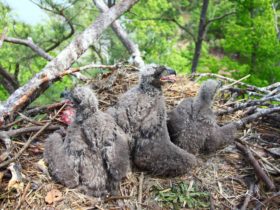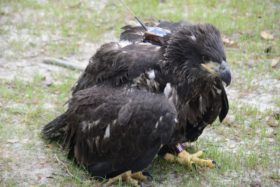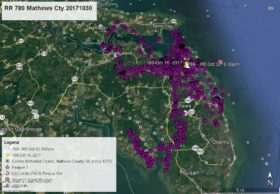A "third eyelid"
Azalea returns to nest – Satellite operations
June 16, 2009Azalea's movements June 14-19
June 19, 2009
 Last evening while HK was sitting near the camera you saw some very close up views of his eyes. Birds have two eyelids, upper and lower. Birds active during daytime hours raise the lower lid when closing their eye, and nocturnal birds close the upper lid. But birds also have a translucent nictitating membrane, sometimes called a “third eyelid”. This membrane closes across the eye from front to back. HK has this membrane closed in these photos. What is it used for? It is used to moisten and clean the cornea, especially in flight. It is also drawn across the eye when there is a chance the eye might be scratched or damaged such as when capturing prey, flying through brush or feeding their young. More about an eagle’s eye in future blogs.
Last evening while HK was sitting near the camera you saw some very close up views of his eyes. Birds have two eyelids, upper and lower. Birds active during daytime hours raise the lower lid when closing their eye, and nocturnal birds close the upper lid. But birds also have a translucent nictitating membrane, sometimes called a “third eyelid”. This membrane closes across the eye from front to back. HK has this membrane closed in these photos. What is it used for? It is used to moisten and clean the cornea, especially in flight. It is also drawn across the eye when there is a chance the eye might be scratched or damaged such as when capturing prey, flying through brush or feeding their young. More about an eagle’s eye in future blogs.




6 Comments
Thanks for explaining that. I was wondering what was going on with HK. Good to know that it is normal!
Glad to get this information as I was watching at this time and noticed the eye transformation. I would love to know how Reese can tell the three chicks apart since they have matured alot
Thanks for this information. It is always interesting to read something new about our birds. These are facts I didn’t know and probably would never come across, except here on this site. Thanks again.
We have thoroughly enjoyed these babies grow. We check every day to see what they are doing.
You have a wonderful web site. We watched last year also and have been following the one with the beak problem.
I teach a kindergarten class in Williamsville, New York. My students and I have loved watching these beautiful creatures over the past 3 months. What an amazing process. Thank you!
It really makes sense to have that third eyelid as a protection for when in flight. Kind of like a bird with goggles! I’ve been on a motorcycle before without a helmet and I couldn’t see, and my eyes watered terribly. Thanks so much, I really enjoy your blog. 🙂